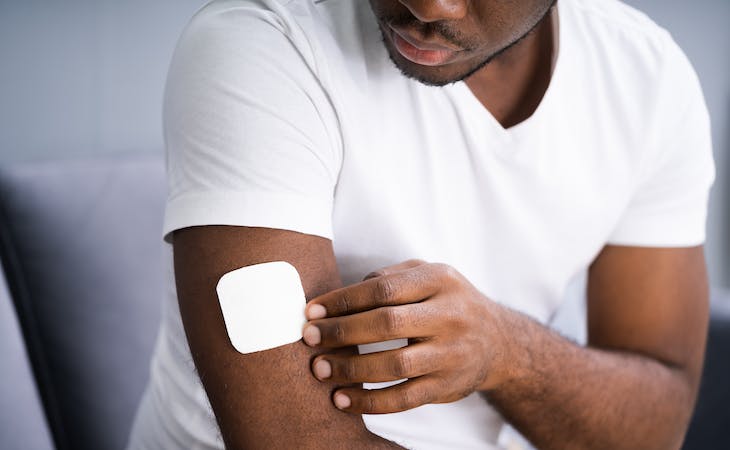Chances are, you’ve seen a new kind of sleep aid come out in recent years: sleep patches. After all, with over 35% of Americans saying they get fewer than seven hours of sleep per night, we’re all just looking for easier ways to fall (and stay!) asleep.
And with sleep patches, we may have found our answer…or have we? Here’s what you need to know about this trendy sleep aid before trying it.
What is a sleep patch?
Essentially, a sleep patch is a transdermal patch with an adhesive backing that allows it to be placed directly on your skin.
“These over-the-counter patches release sleep-promoting substances, such as melatonin, CBD, or L-tryptophan,” explains Tara Youngblood, sleep coach and CEO of Sleep.me. “They are an alternative way of administering sedative medication or supplements.” (Here’s what you need to know about OTC sleep aids.)
Sleep patches come in various sizes, shapes, and types, and several brands make them. They all contain different concentrations of ingredients, from straight melatonin to a combination of adaptogens, CBD, or nootropics.
Some common sleep patch brands include Deeps (containing cannabinoids, melatonin, and valerian), The Good Patch (containing hemp and melatonin), and Klova (containing various amounts of valerian, melatonin, L-theanine, magnesium, GABA, and a number of other options).
How do sleep patches work?
Sleep patches work by allowing the ingredients to penetrate the skin and make their way into the bloodstream.
“In layman’s terms, the job of your skin is to keep things out,” says Sudha Tallavajhula, MD, sleep medicine neurologist at UTHealth Houston Neurosciences. “But if the drug/supplement is small enough, then it can transfer through the skin. As you sleep, the substance transfers to your body.”
While all kinds of sleep patches haven’t been tested, studies on transdermal melatonin show it can be effective in transmitting the substances through your skin and into your system.
Some sleep patches also utilize sustained-release technology. This means they slowly transmit the ingredients into your bloodstream so you stay asleep throughout the night.
The argument here is that otherwise, the ingredients peak too early in your bloodstream and lose effectiveness later. However, there haven’t been enough studies done on oral versus sustained-release patch dosage in order to compare the two.
Specific instructions may vary based on the particular sleep patch you select. Typically, the process includes applying the patch about an hour before bedtime—similar to taking an oral supplement.
Some brands recommend choosing an area that’s comfortable and as hair-free as possible, such as your forearm, shoulder, calf, or the top of your foot.
You’d go to sleep with the patch on and remove it in the morning. Any adhesive that remains once the patch is removed can be cleaned off with soap and water. Most patches are for one-time use only, and a box usually comes with multiple patches.
Are sleep patches more effective than taking oral supplements?
According to Tallavajhula, sleep patches may have multiple benefits over taking oral supplements. These include:
- They provide a slower release of the ingredients during the night. This may help people who have trouble staying asleep due to the sustained-release technology in the patches.
- They’re easy to use since you don’t need to chew or swallow them. Simply put on a patch an hour before bed and you’re good to go.
- They’re cost-effective. Most patches are about $4-$5 for one.
- They bypass your digestive system and are absorbed directly into your bloodstream through the skin. “This increases bioavailability or the amount of the supplement your body is able to process,” says Tallavajhula. “What is in your stomach matters when it comes to how much your body can absorb and use at any time.” For example, processed and acidic foods can reduce absorption. “So getting your melatonin and other supplements transdermally, on a patch on your skin, can avoid that problem,” says Tallavajhula. “You can get more of those supplements into your system—which can, in turn, increase effectiveness.”
- They’re unlikely to contain sugar or filler ingredients. “Many oral supplements on the market don’t contain the pure ingredients and are filled with synthetics or sugar in order to make them more palatable,” says Tallavajhula. “This can wreak havoc on your gut health, so it’s best to source the best supplements possible or invest in a patch instead.”
Do sleep patches have any side effects?
In general, there are no major adverse effects for most people. However, you could experience the same side effects that happen from taking supplements orally, says Tallavajhula. This may be more to do with the ingredients rather than the fact that they’re being administered transdermally via patches.
Some common side effects from taking too much melatonin or other sleep-inducing drugs could include headaches, dizziness, irritability, temporary depressive feelings, and stomach cramps, says Youngblood.
“Because melatonin also induces sleepiness, you should avoid driving a car or operating heavy machinery while under the effects of supplemental melatonin,” she adds.
As with any other over-the-counter sleep-inducing medications, keep in mind that sleep patches are intended for temporary use, cautions Tallavajhula.
If your sleep problems perpetuate, it’s best to see your doctor. “Prescription sleep agents and more sustainable treatments like cognitive behavioral therapy for insomnia have stronger research supporting their use,” notes Tallavajhula.
FAQs
How long does it take for sleep patches to work?
Most sleep patches take about 20-40 minutes to start working and continue to slowly release ingredients while you sleep. Most brands recommend you apply a patch about an hour before bedtime.
Is melatonin absorbed through the skin?
Yes, melatonin can be absorbed through the skin. Although most research is around the effectiveness of taking melatonin orally, there are some smaller studies suggesting transdermal melatonin can help people with irregular sleep patterns.
How long does a melatonin patch last?
Melatonin patches are meant to be worn for eight to 12 hours while you sleep. They slowly release the ingredient into your bloodstream throughout the night. Individual sleep patches are meant for single use only.
The bottom line on sleep patches
Overall, there aren’t really any risks when it comes to sleep patches—as long as you use them correctly, don’t go above the recommended dosage amounts, and understand that they’re primarily for short-term use.
And while most of the ingredients in sleep patches are backed by science, they may not work for everyone. “Each individual is different, so it’s imperative to try a few options to see which one works best for you,” shares Tallavajhula.




